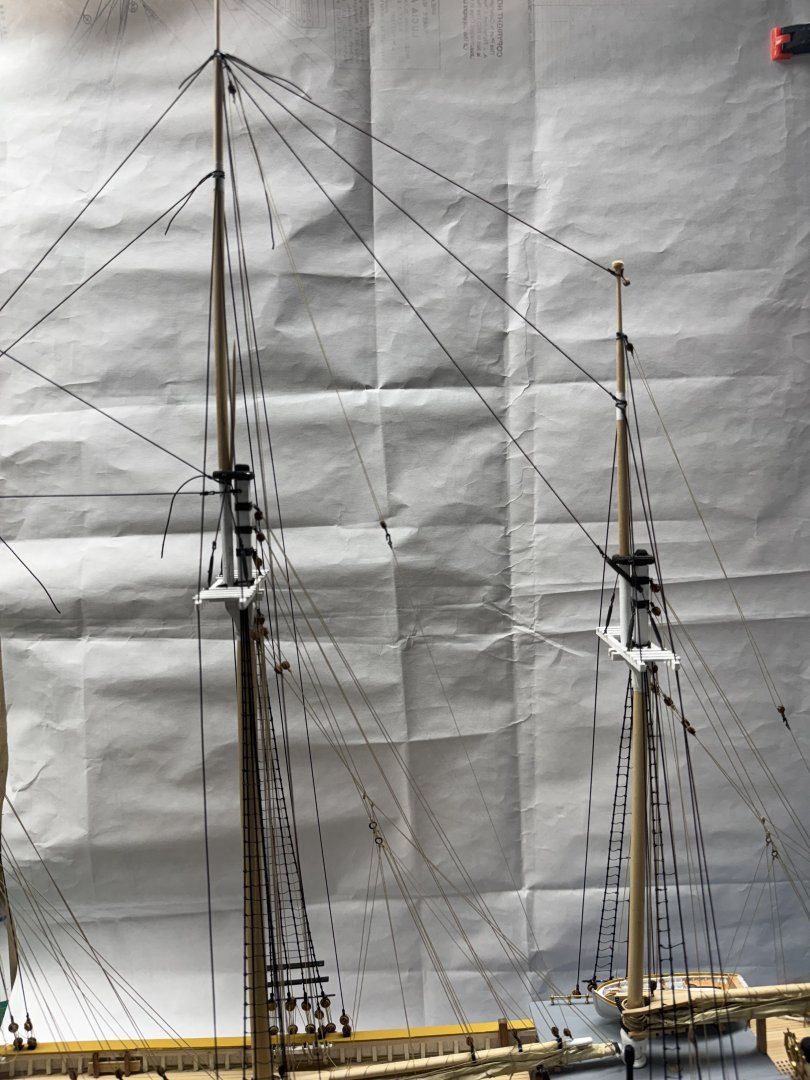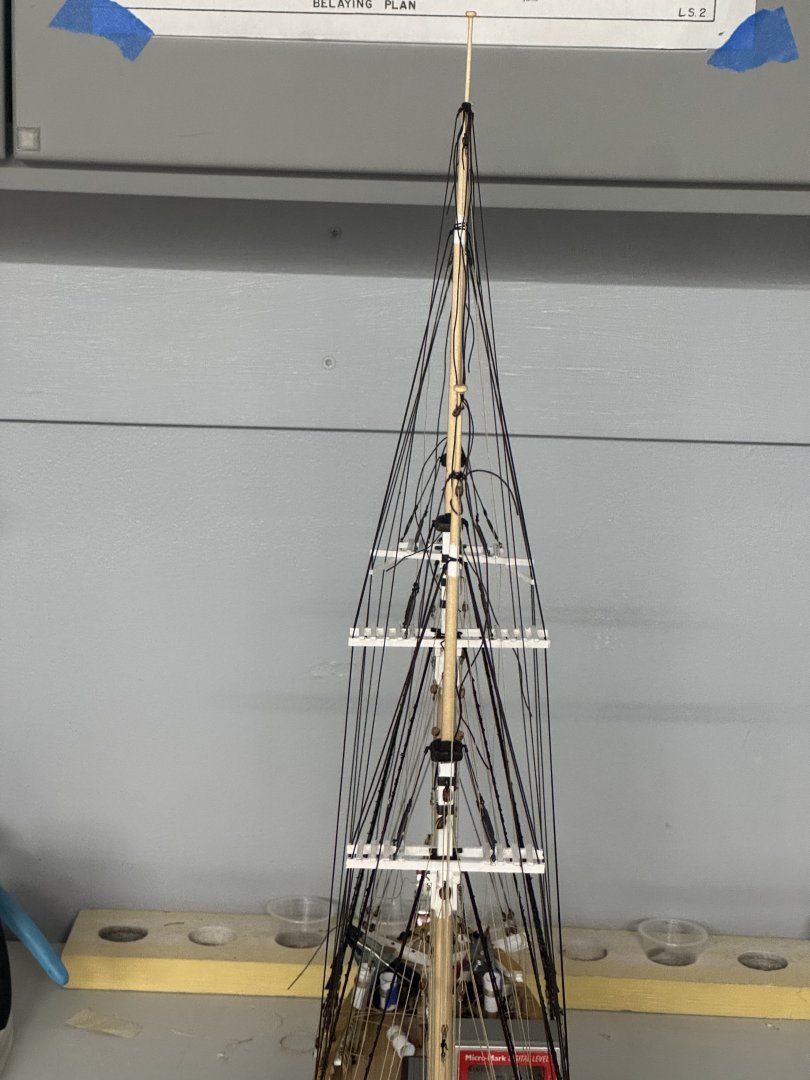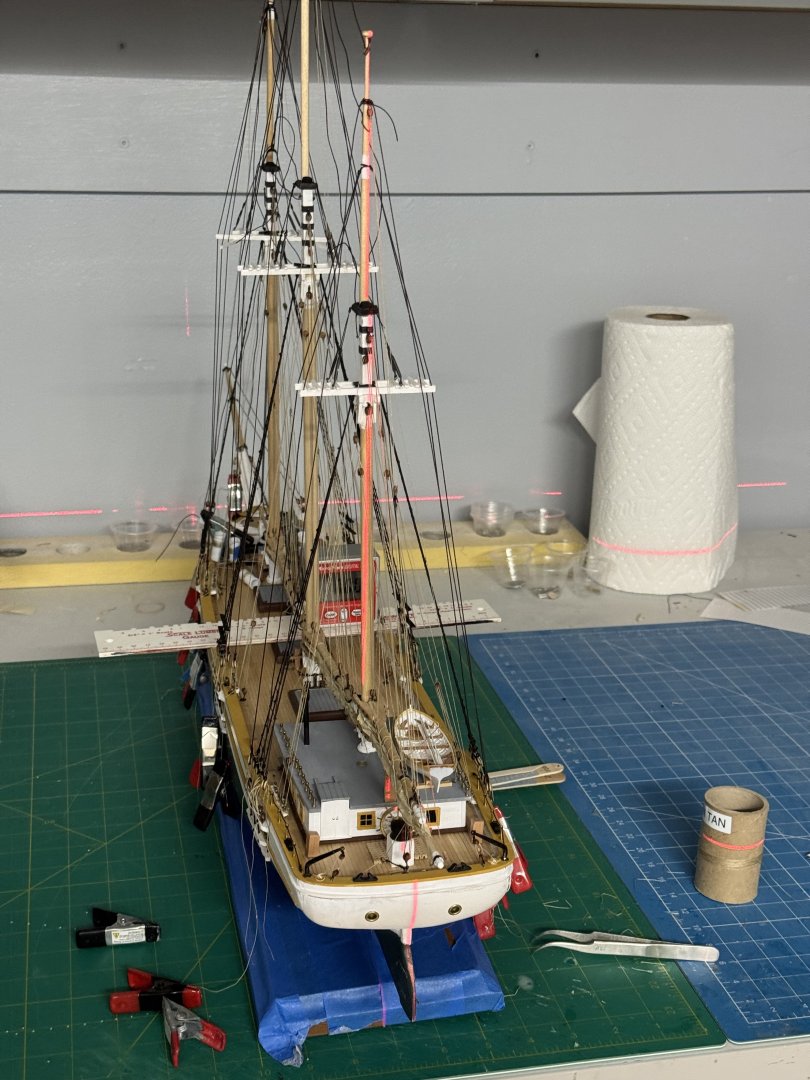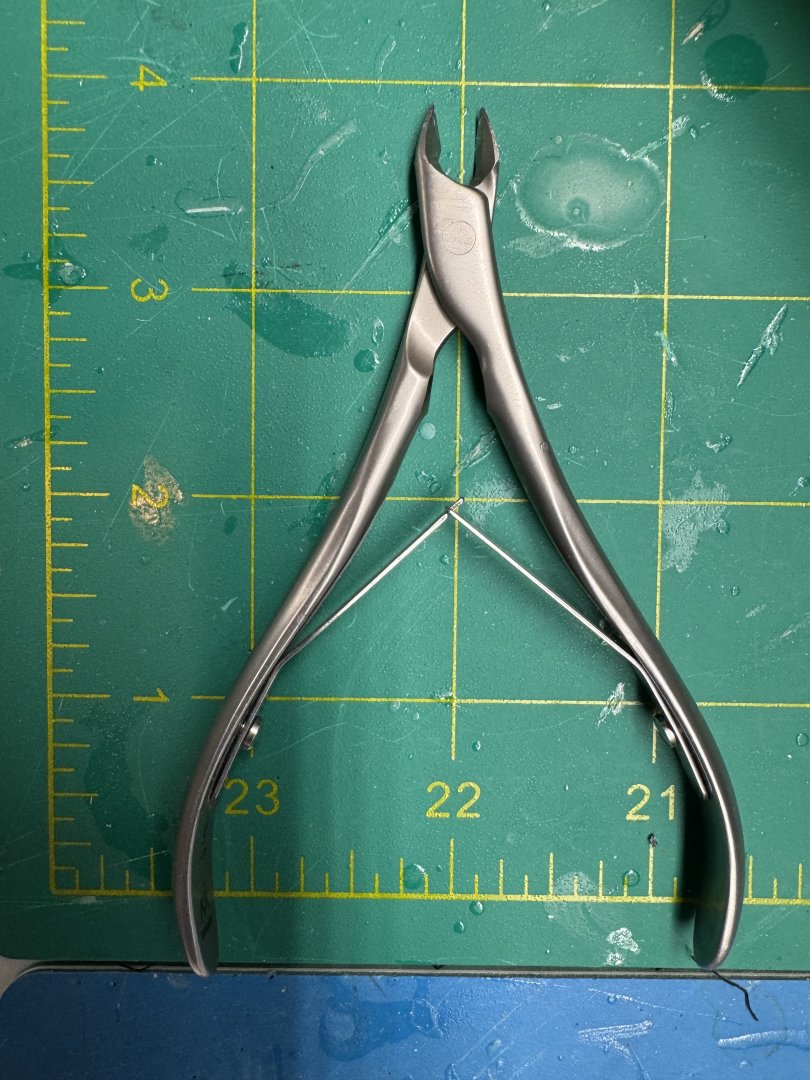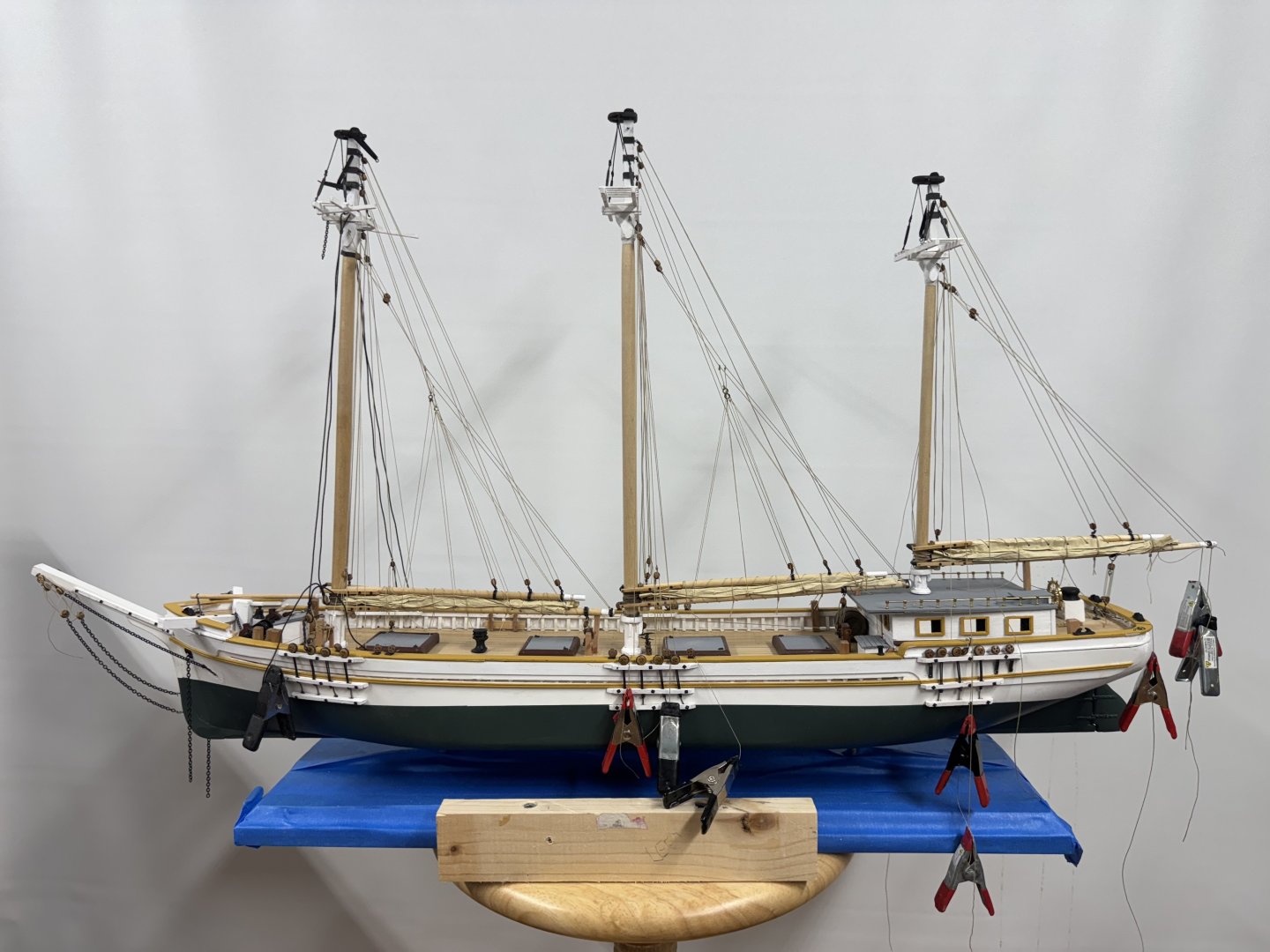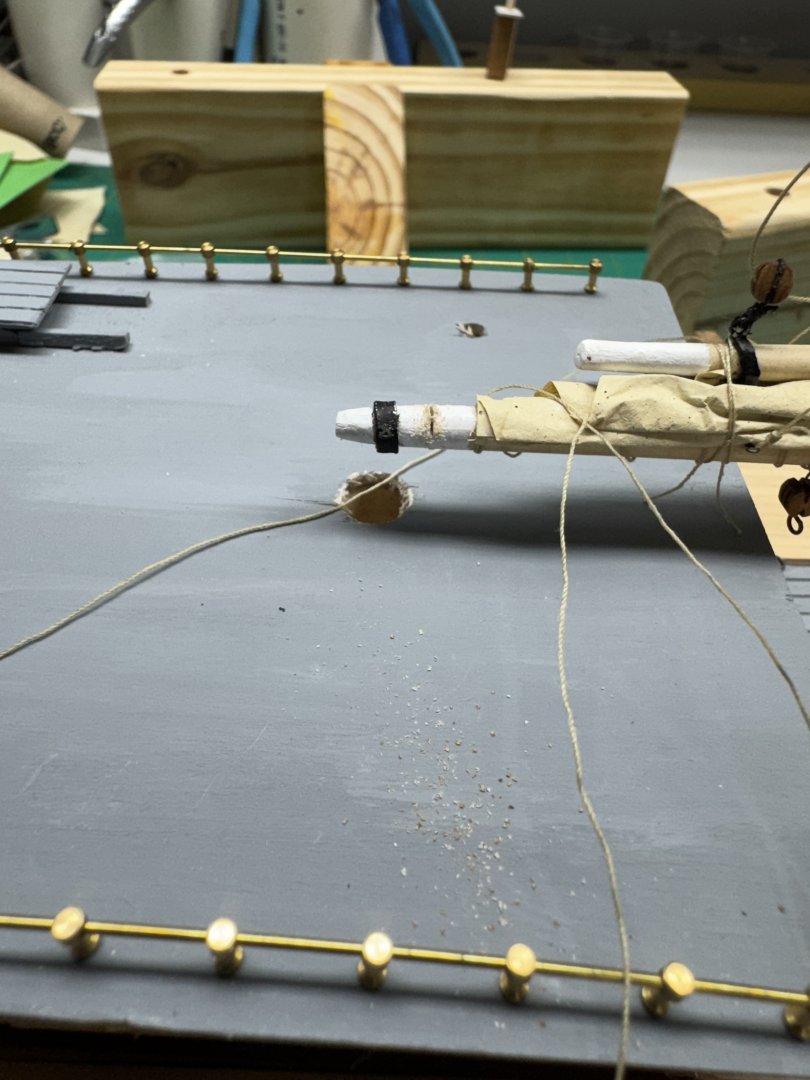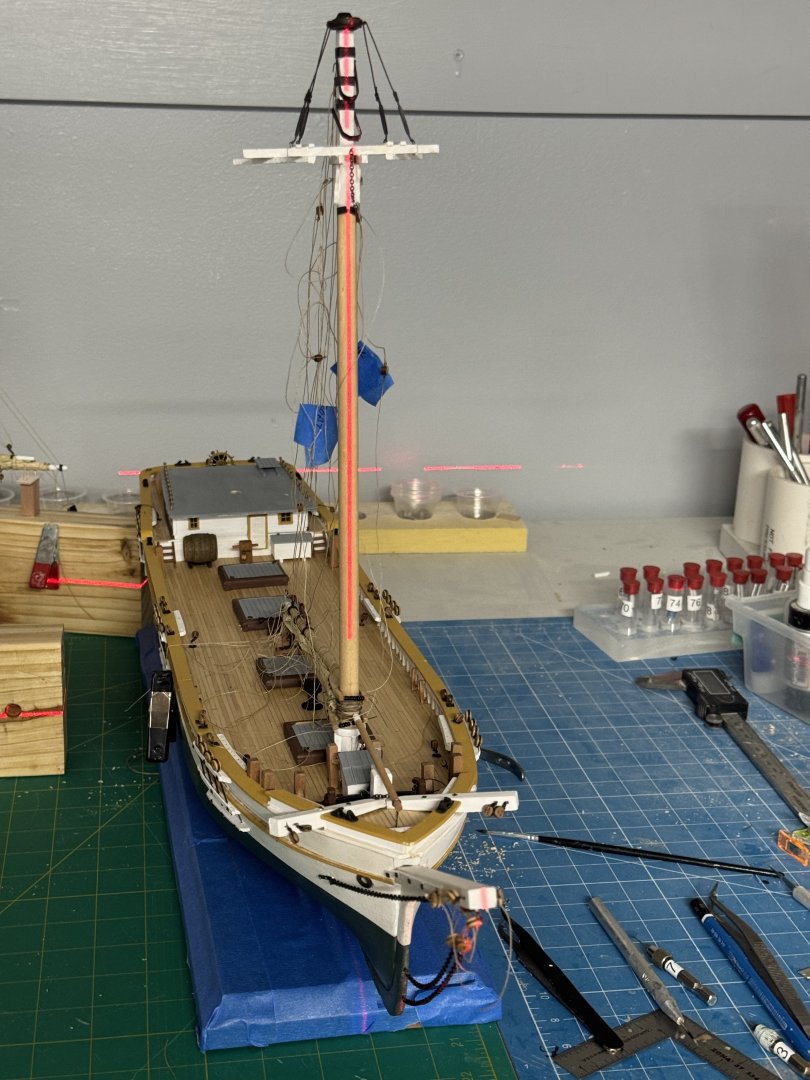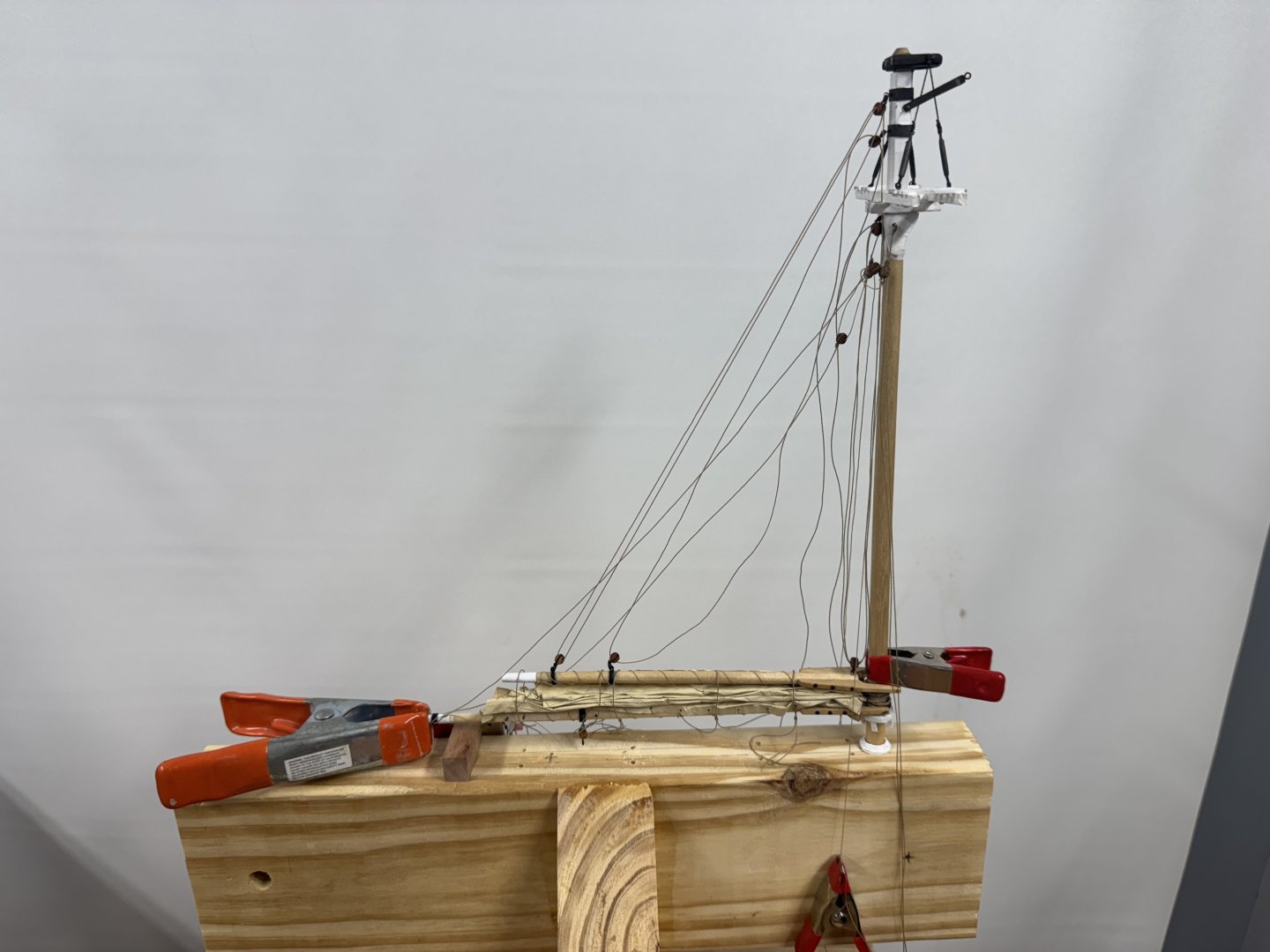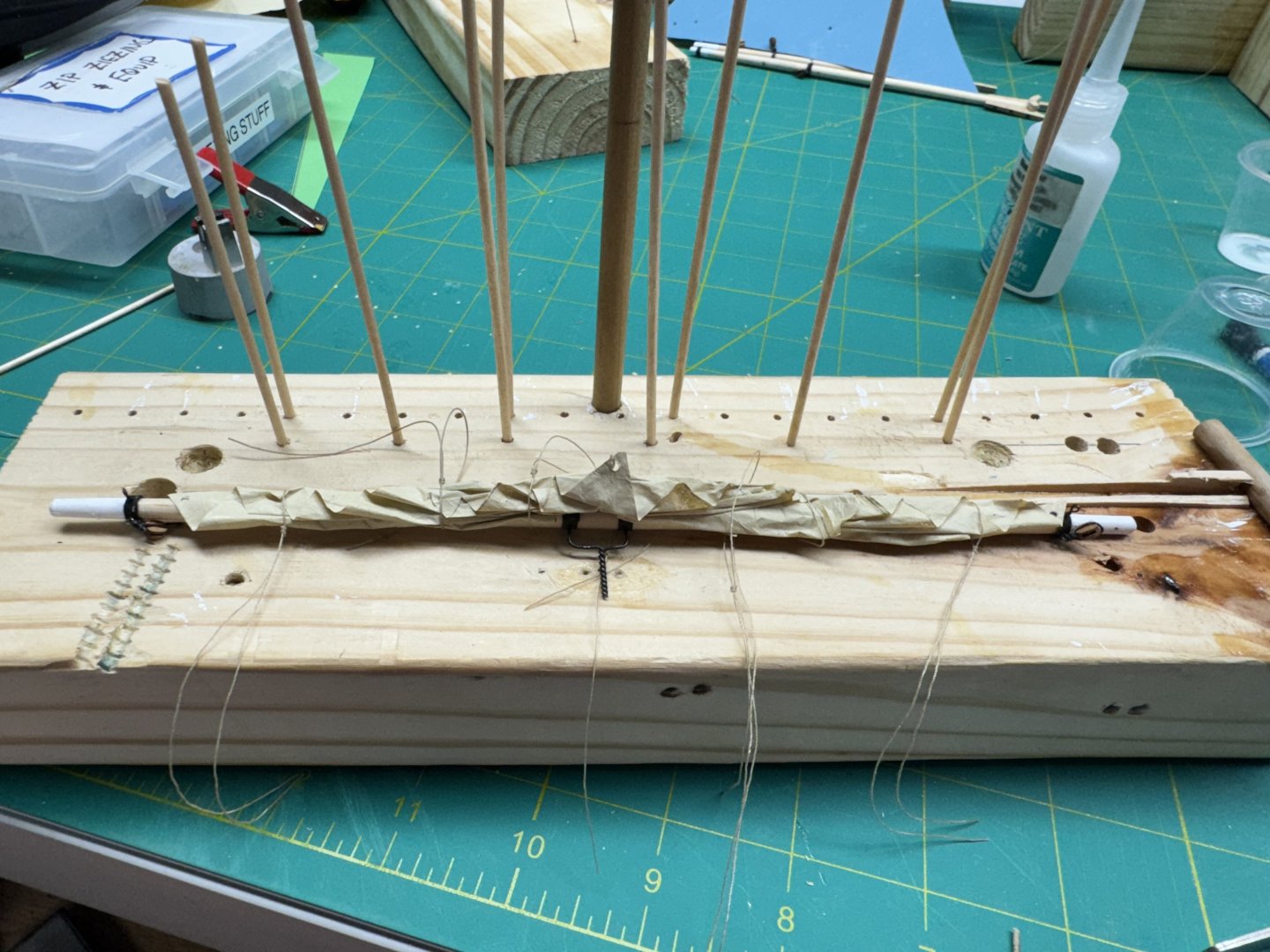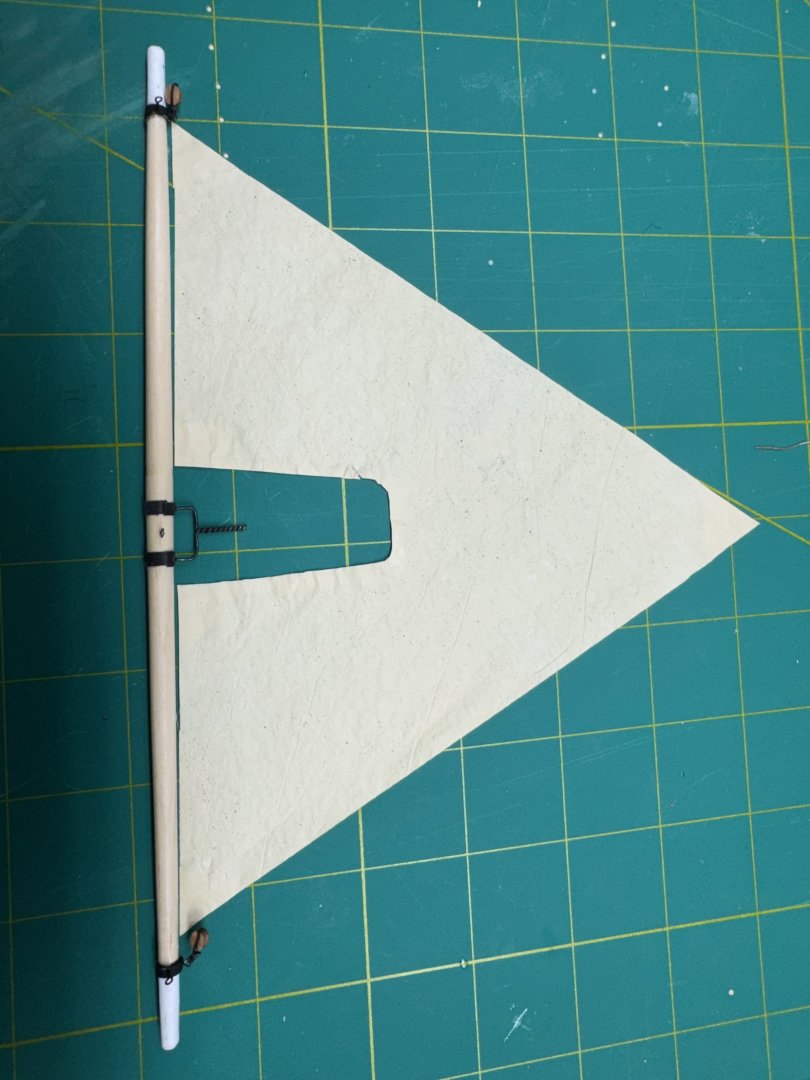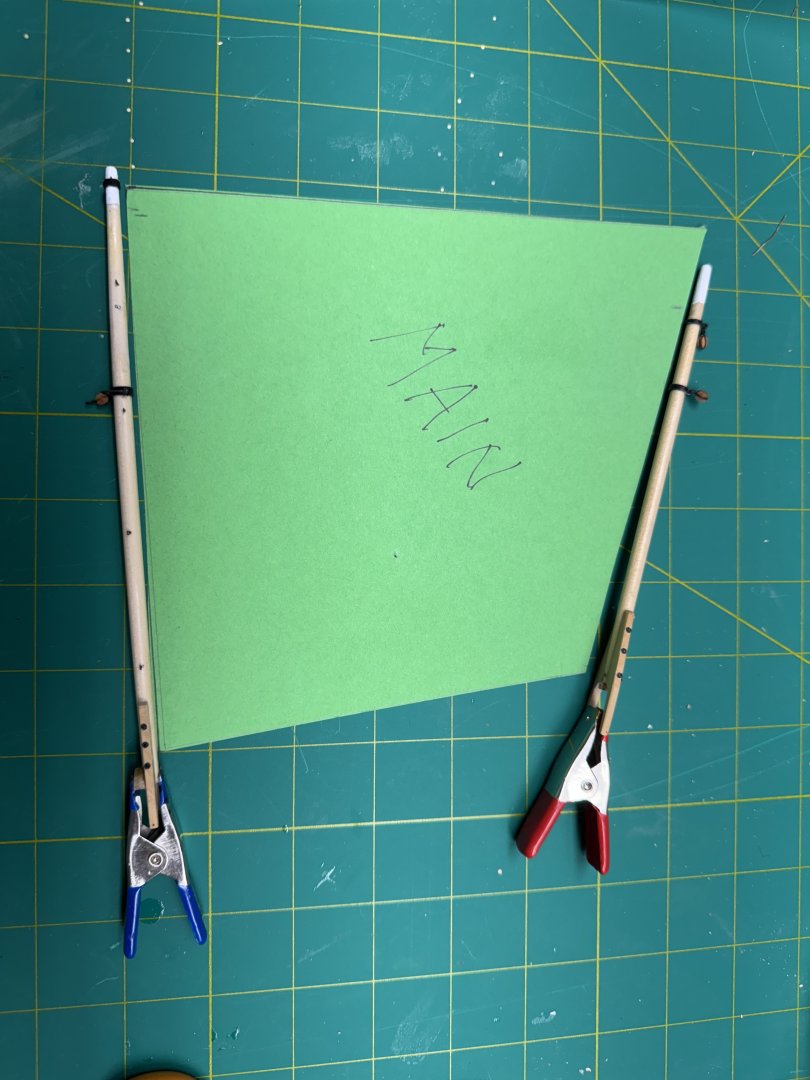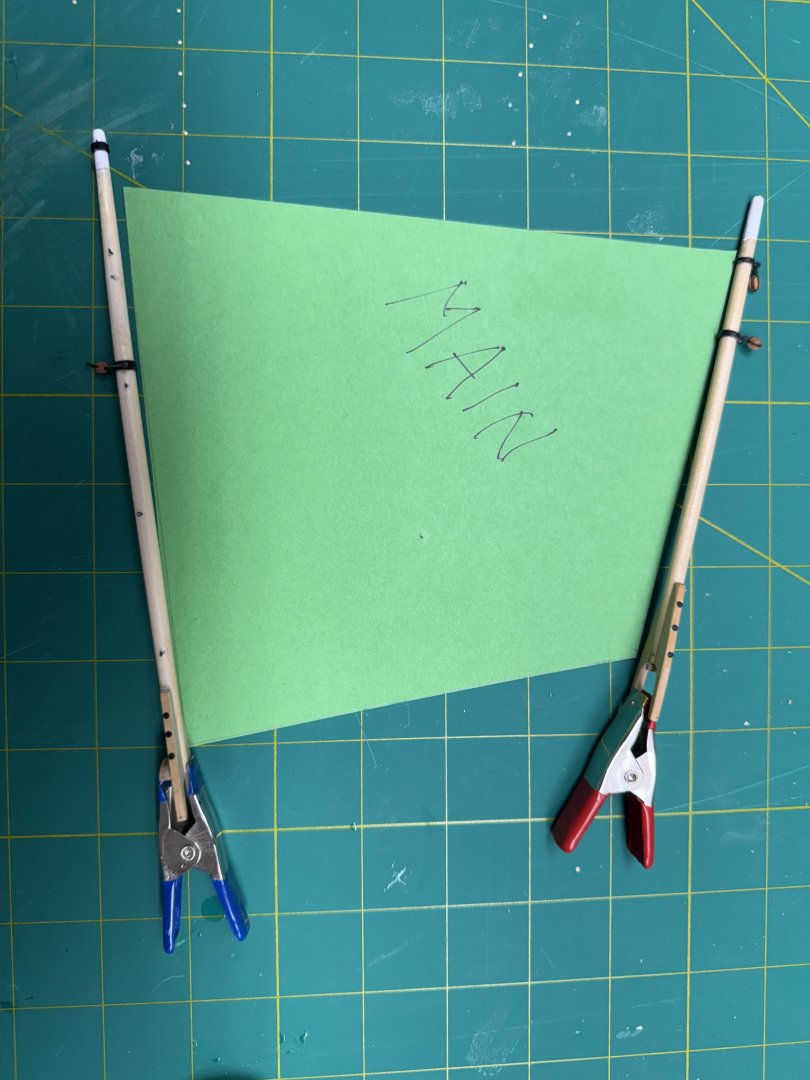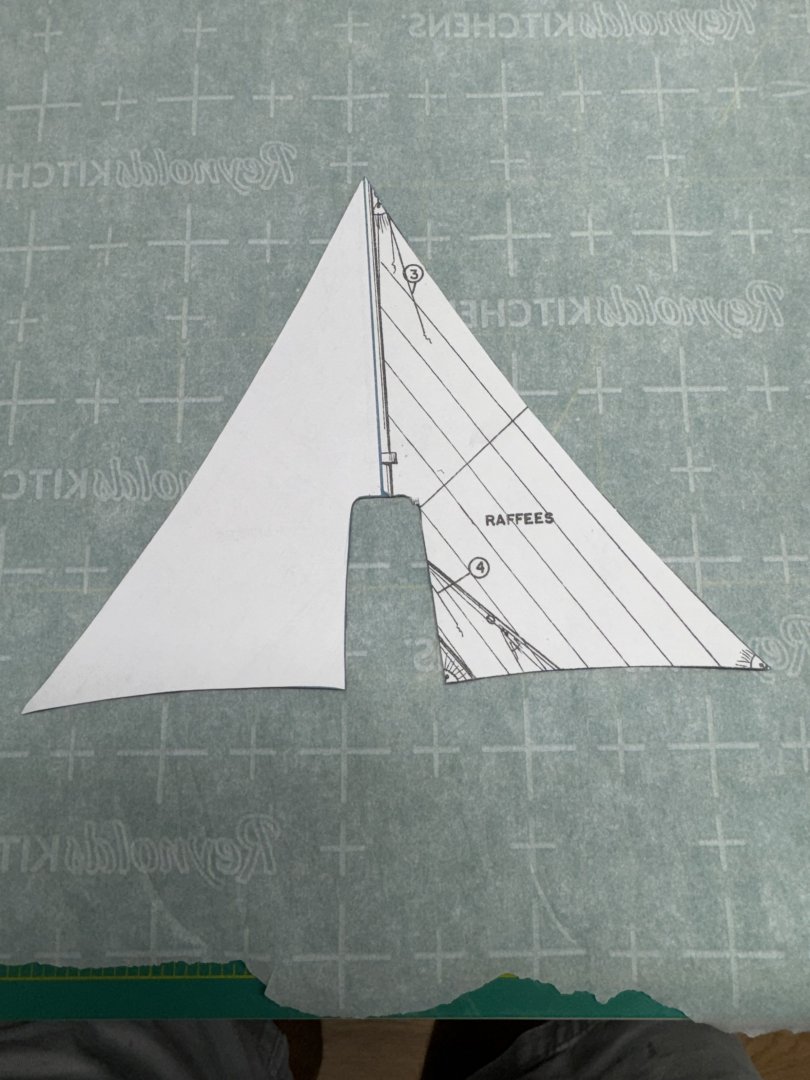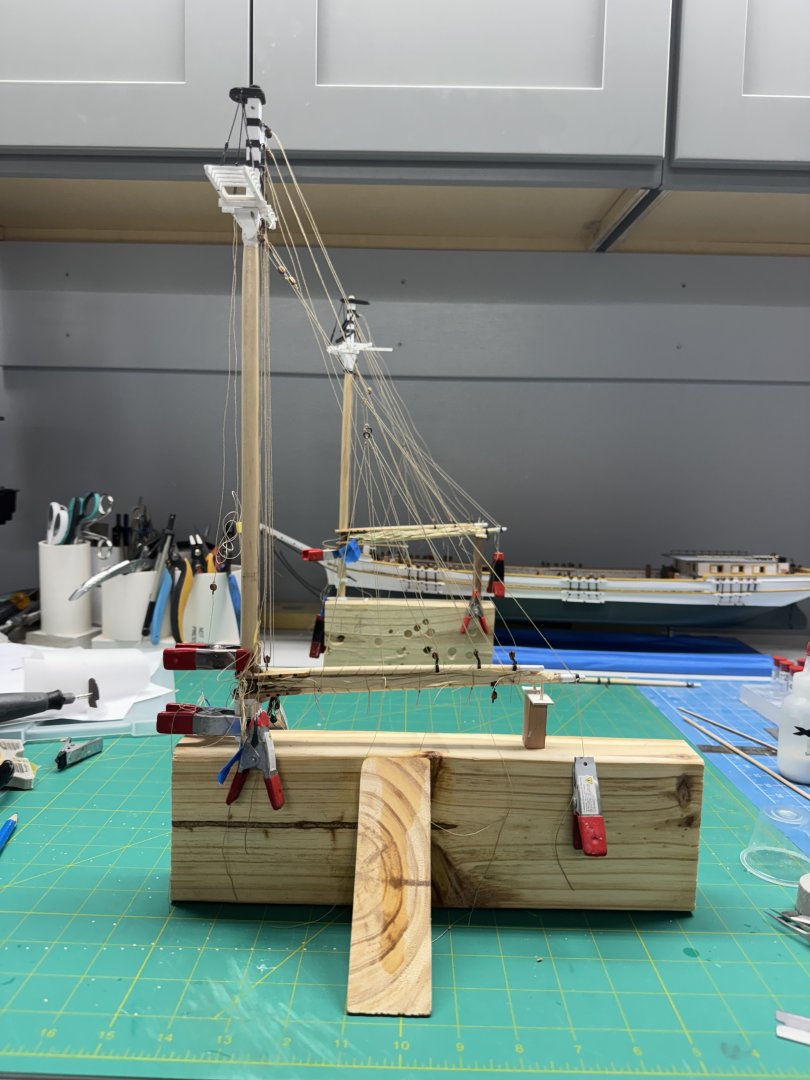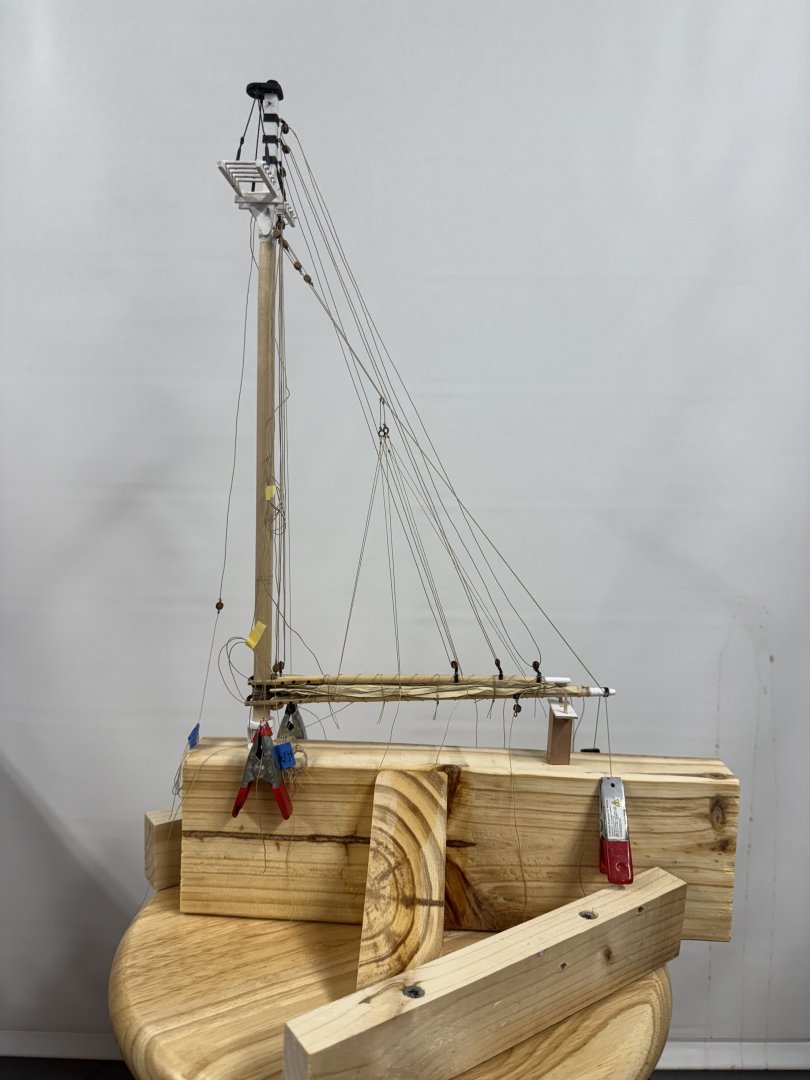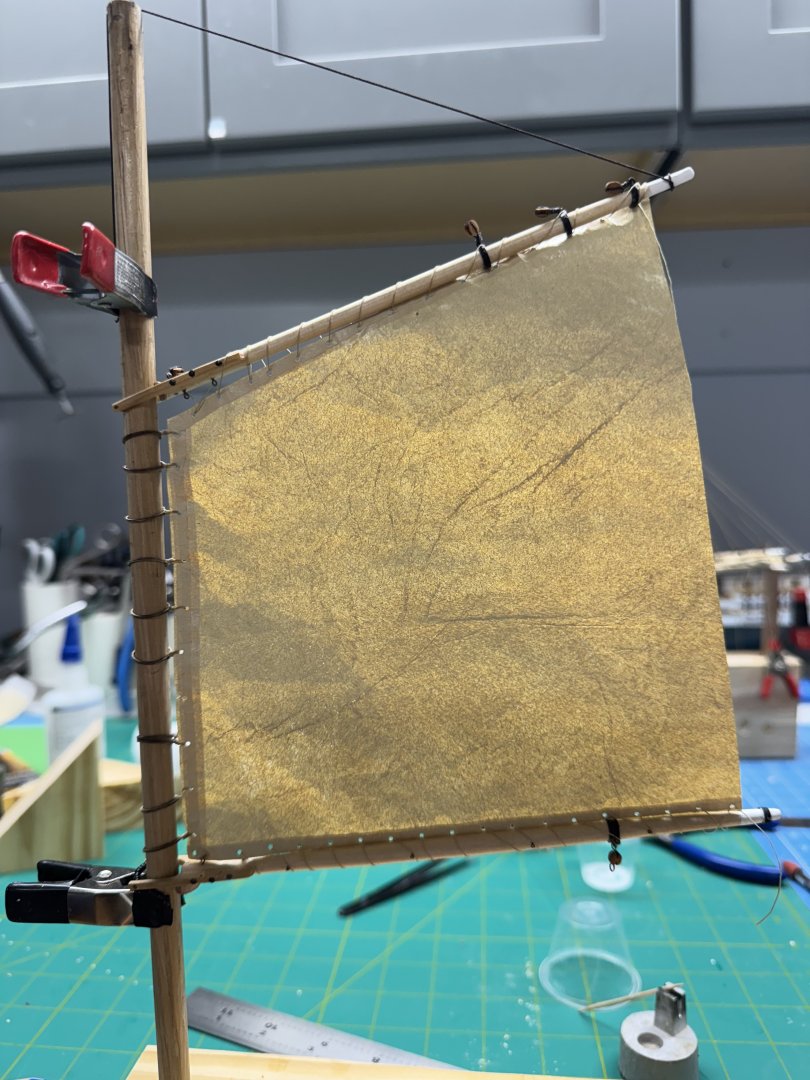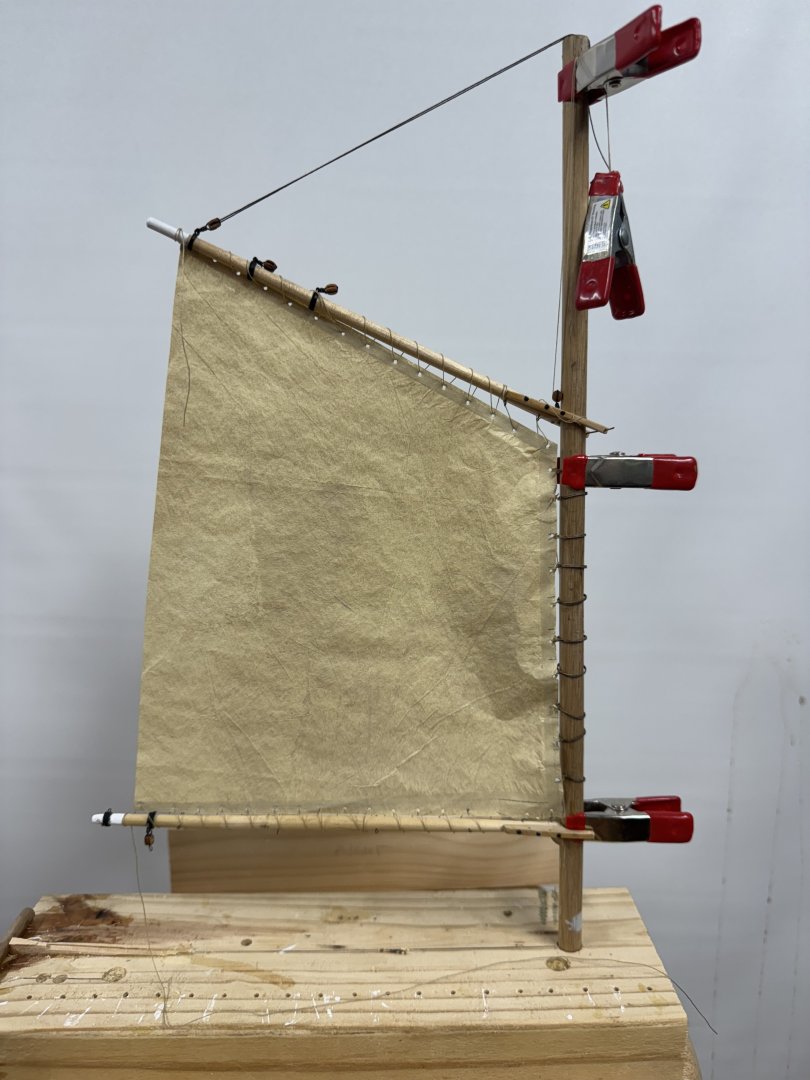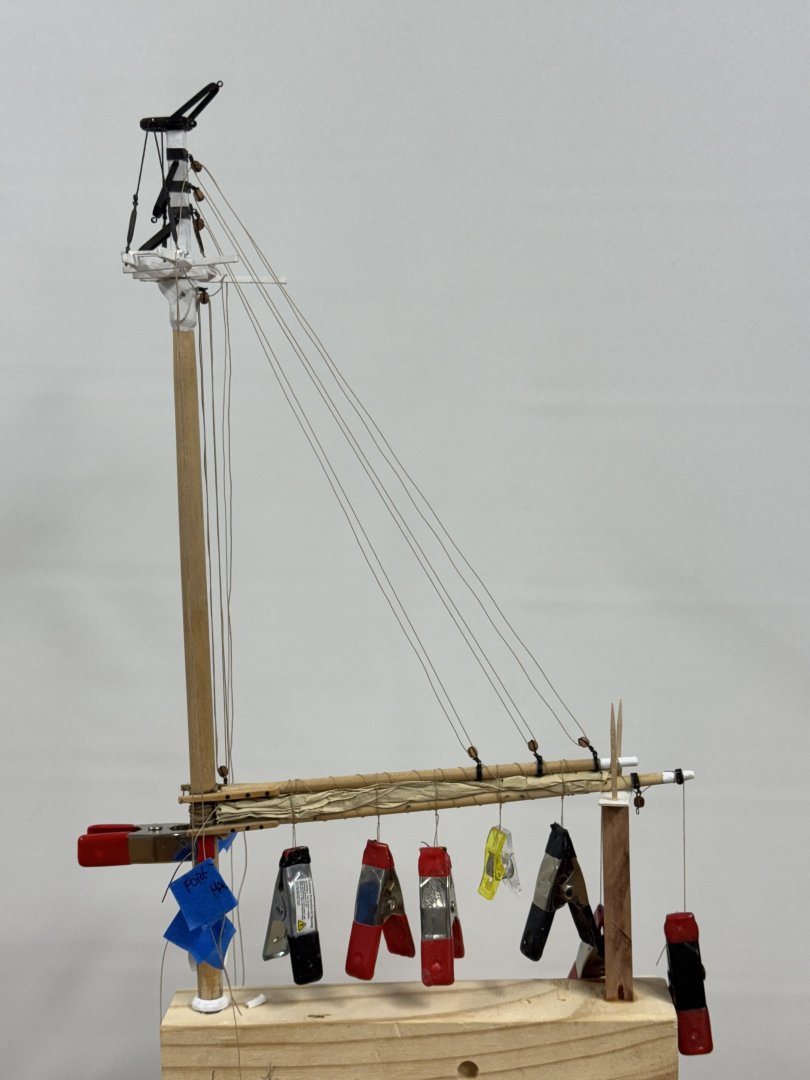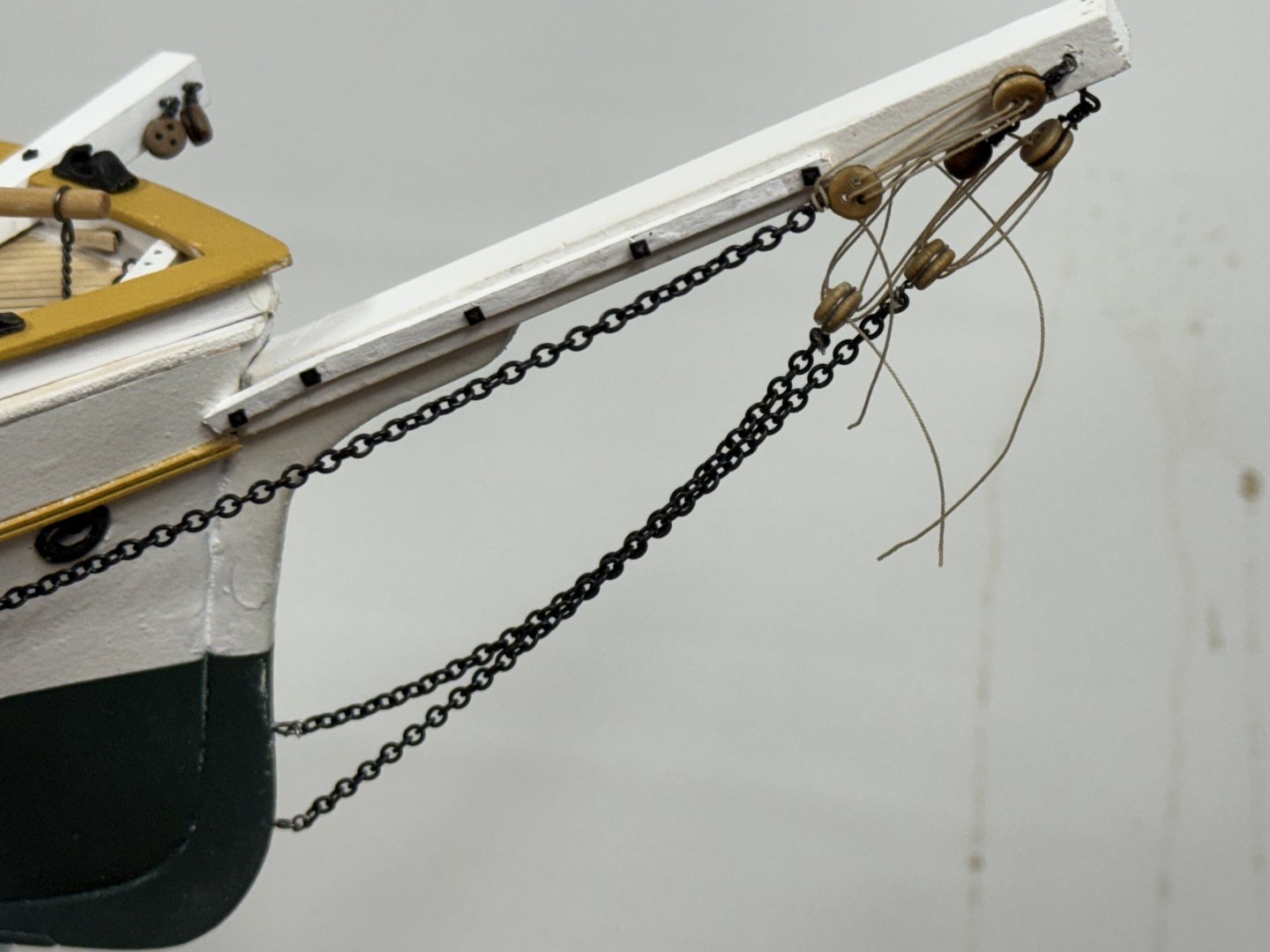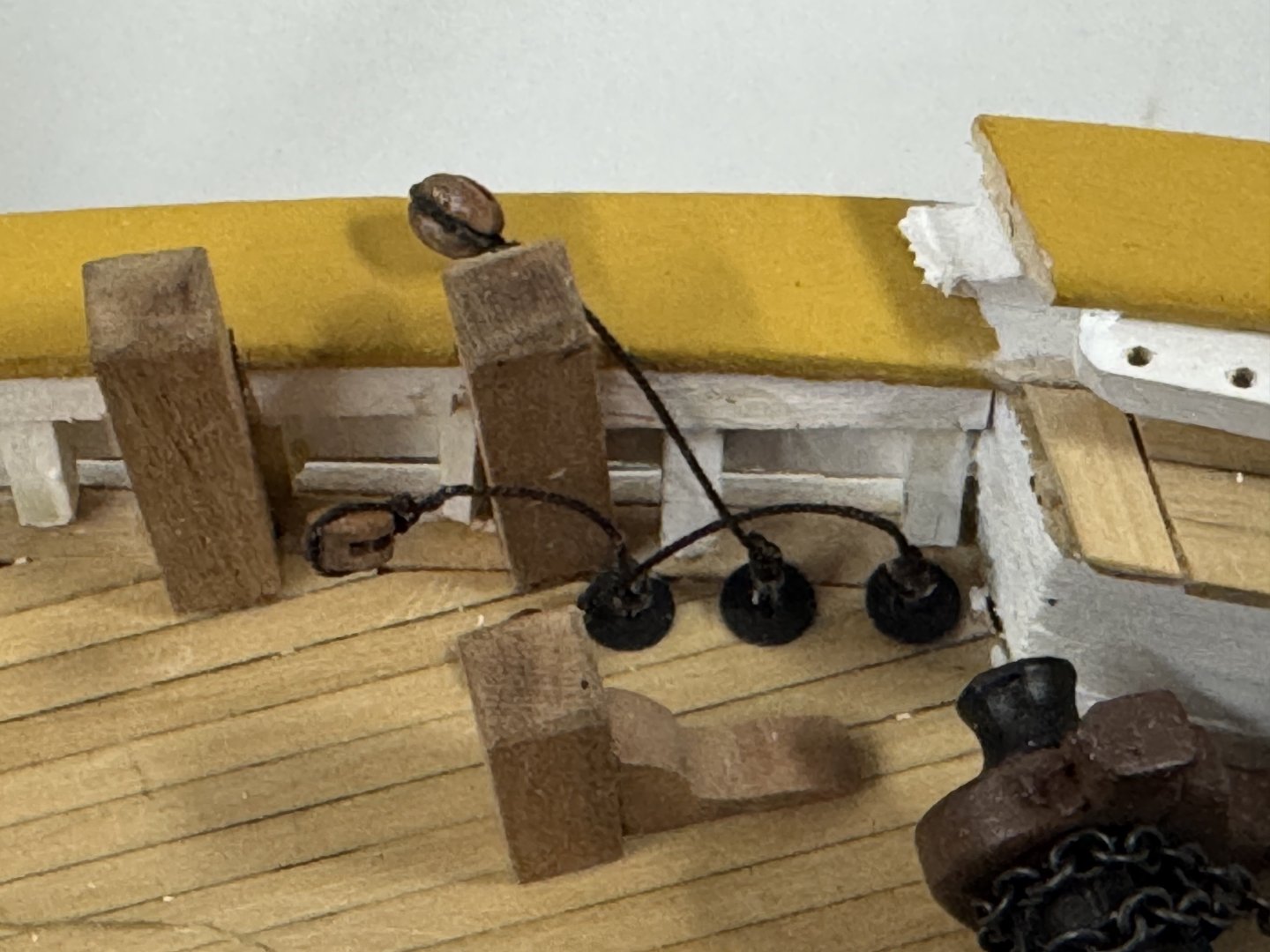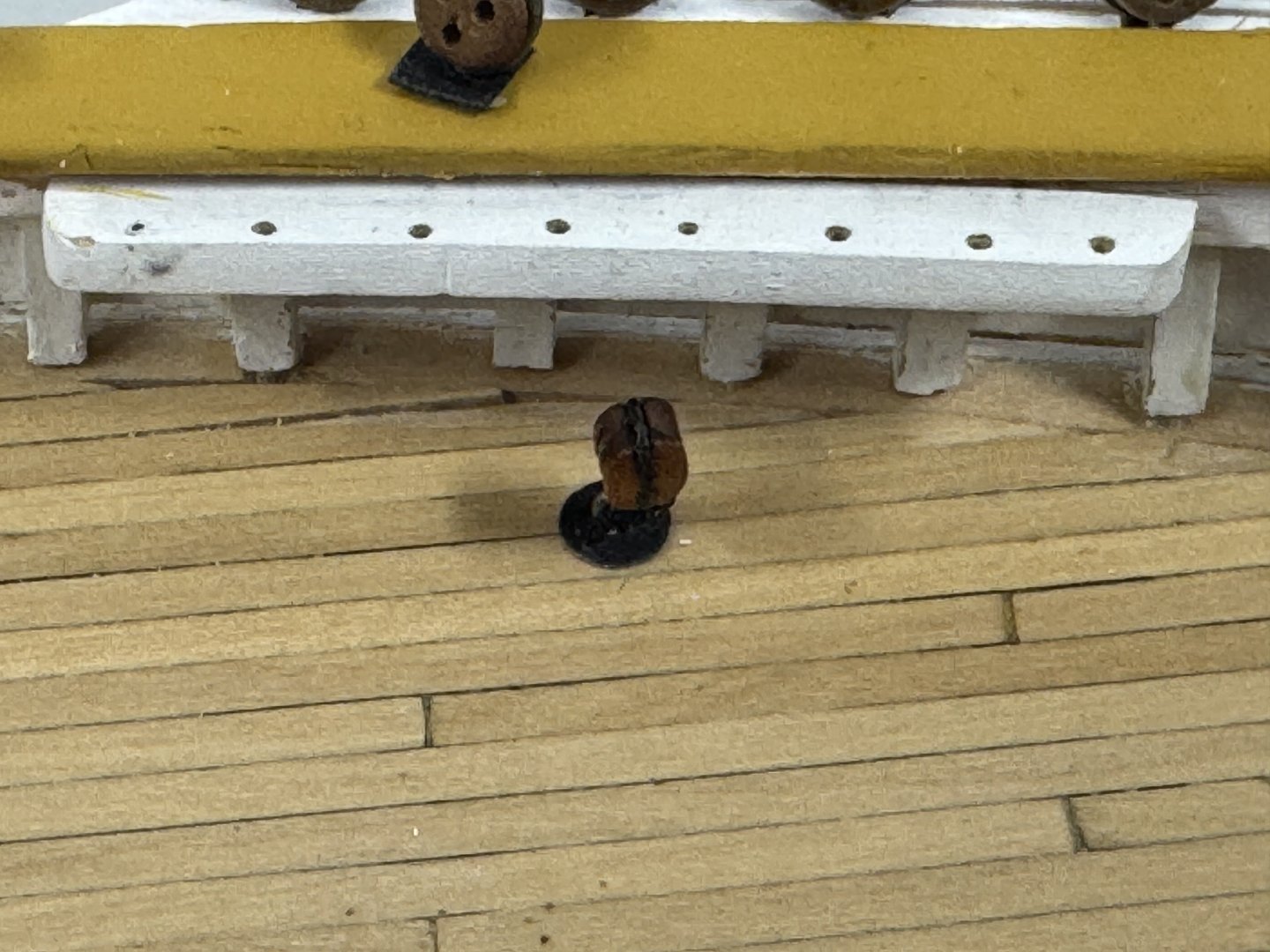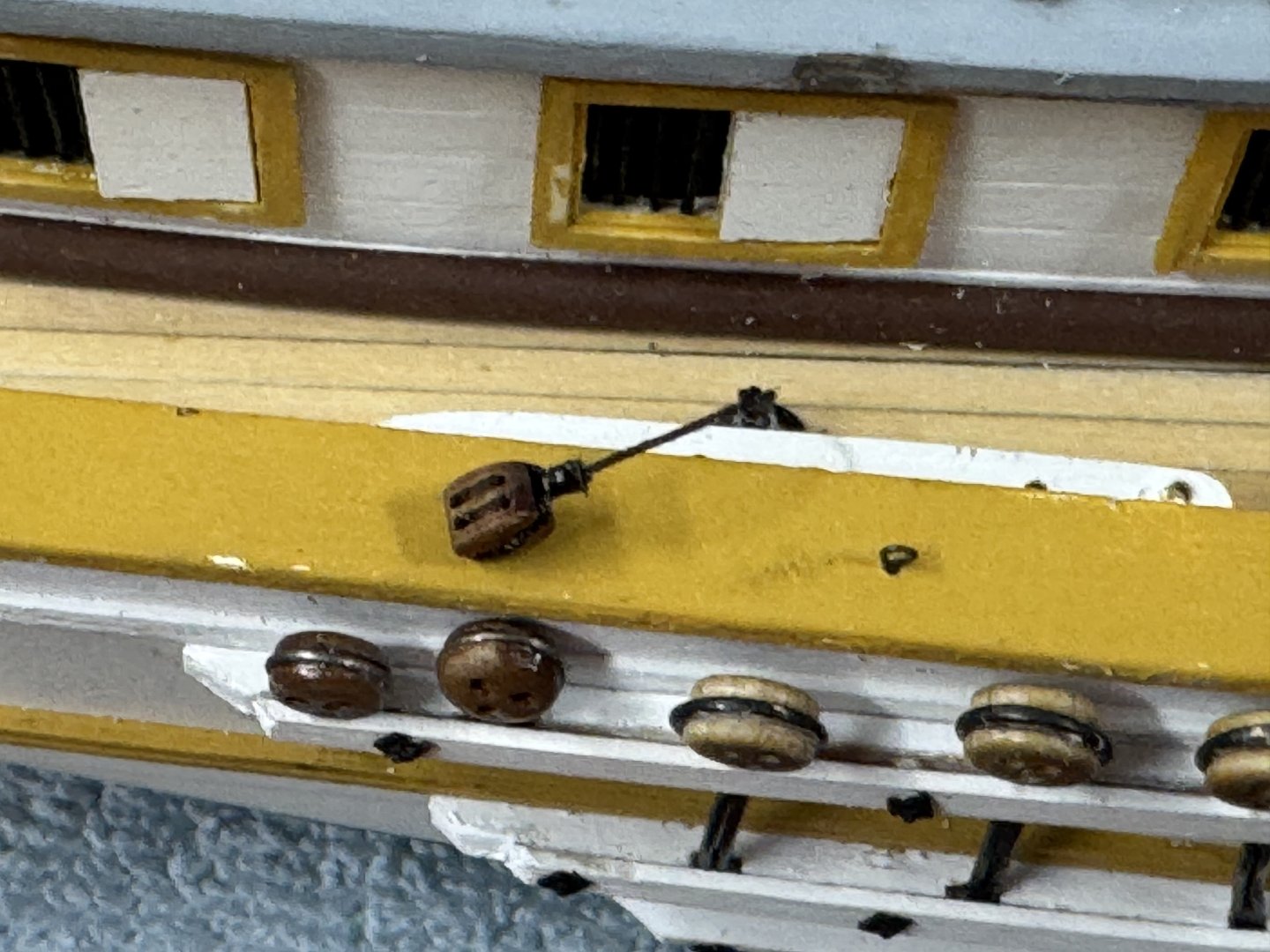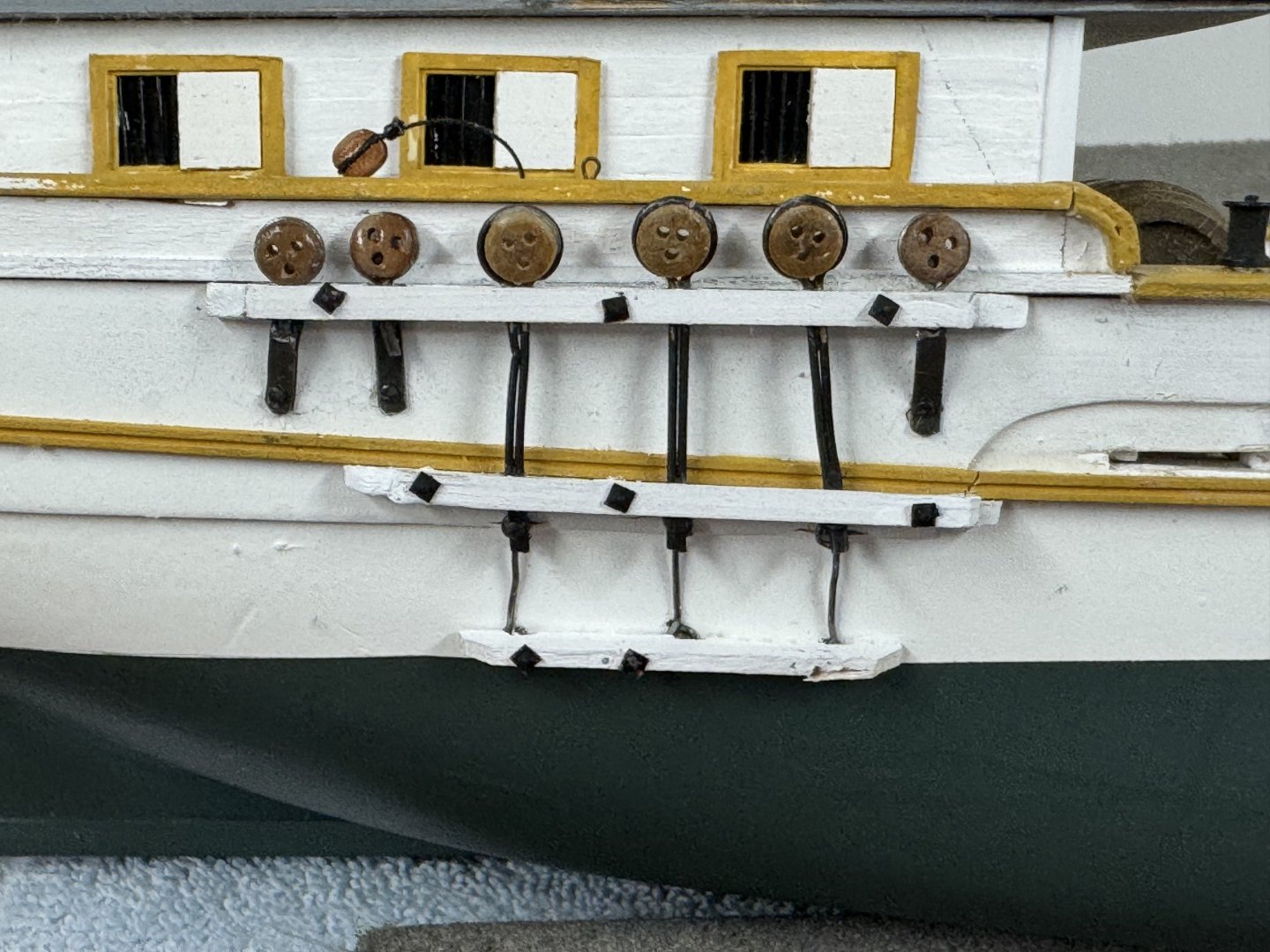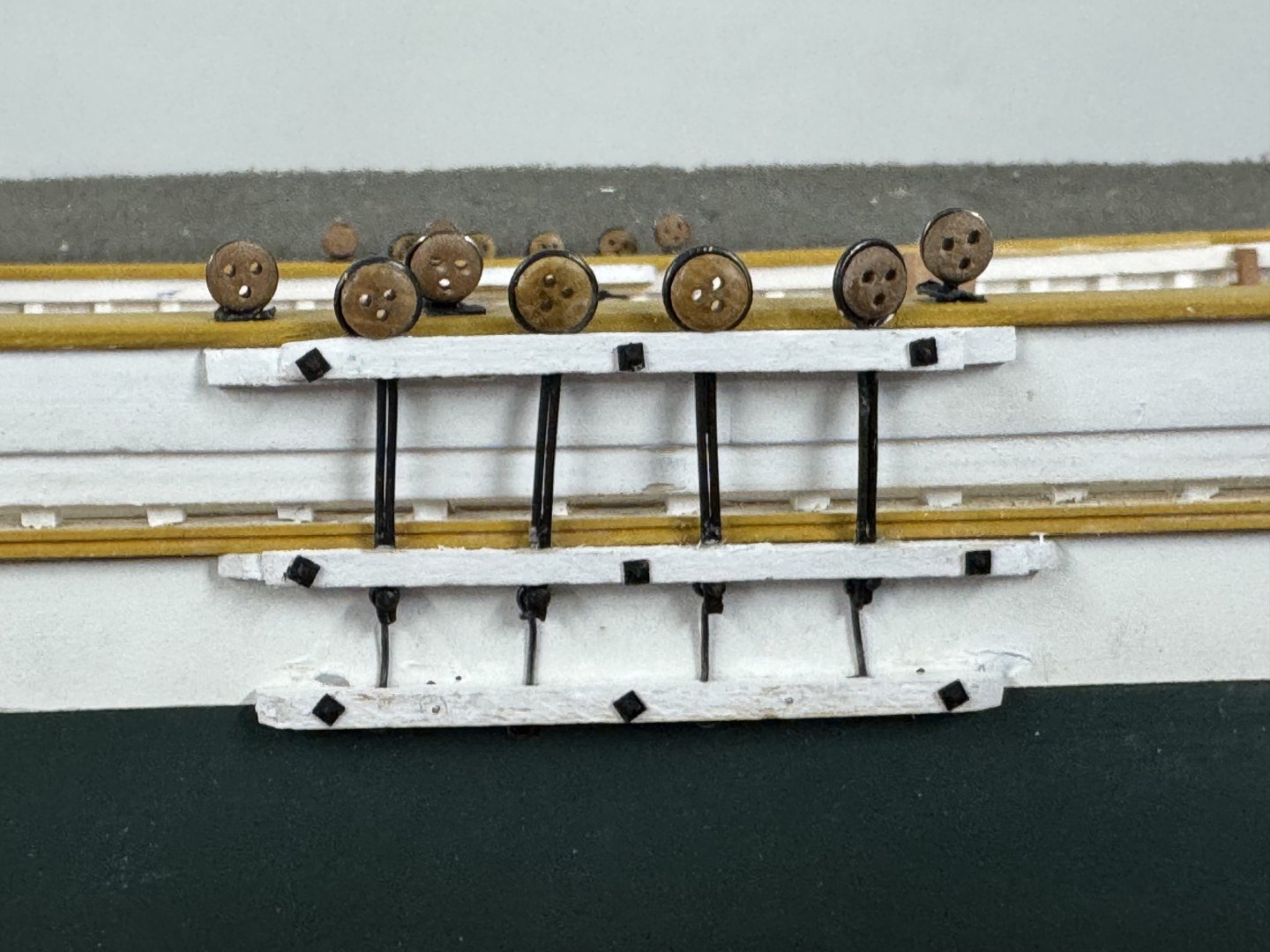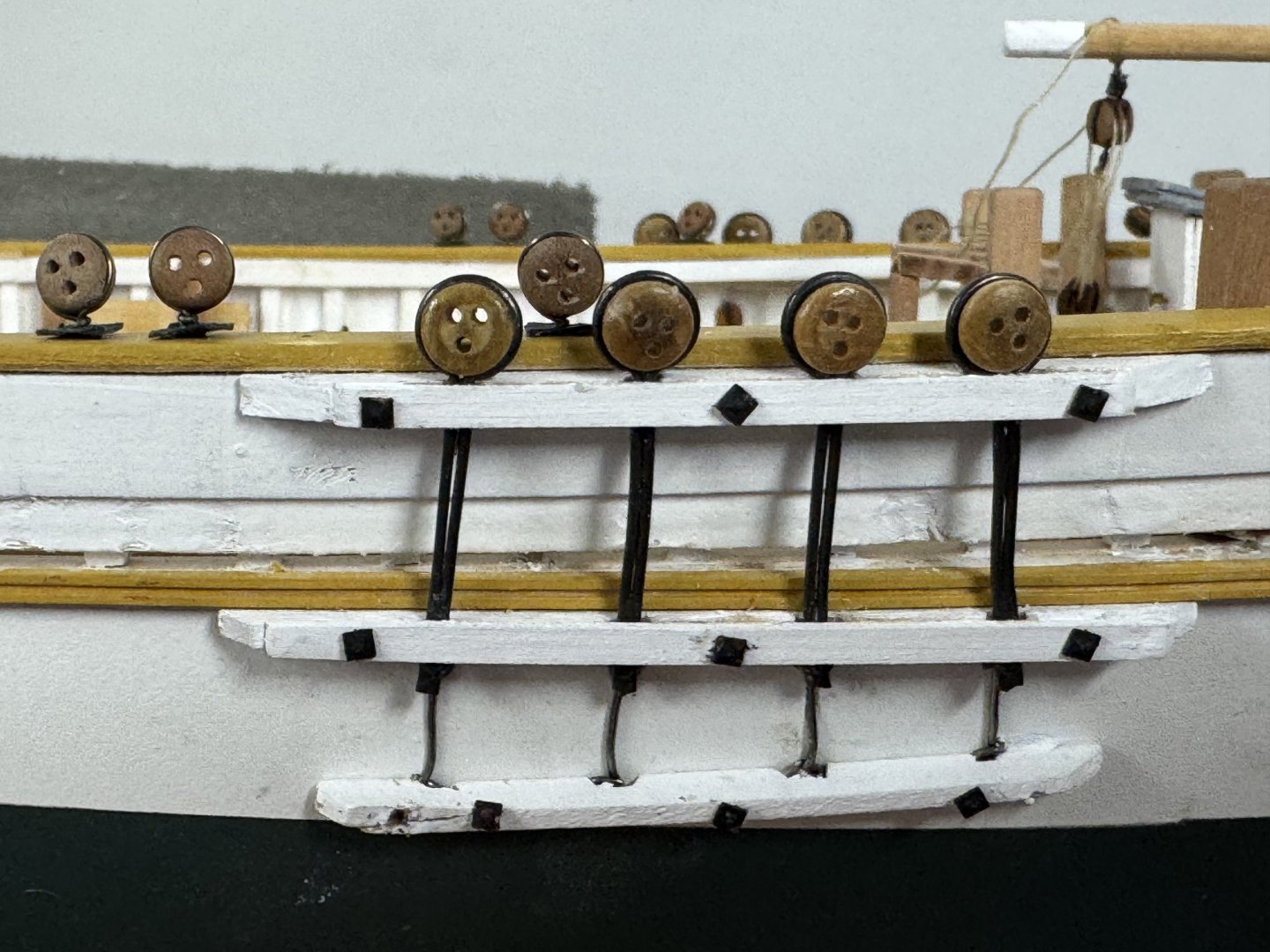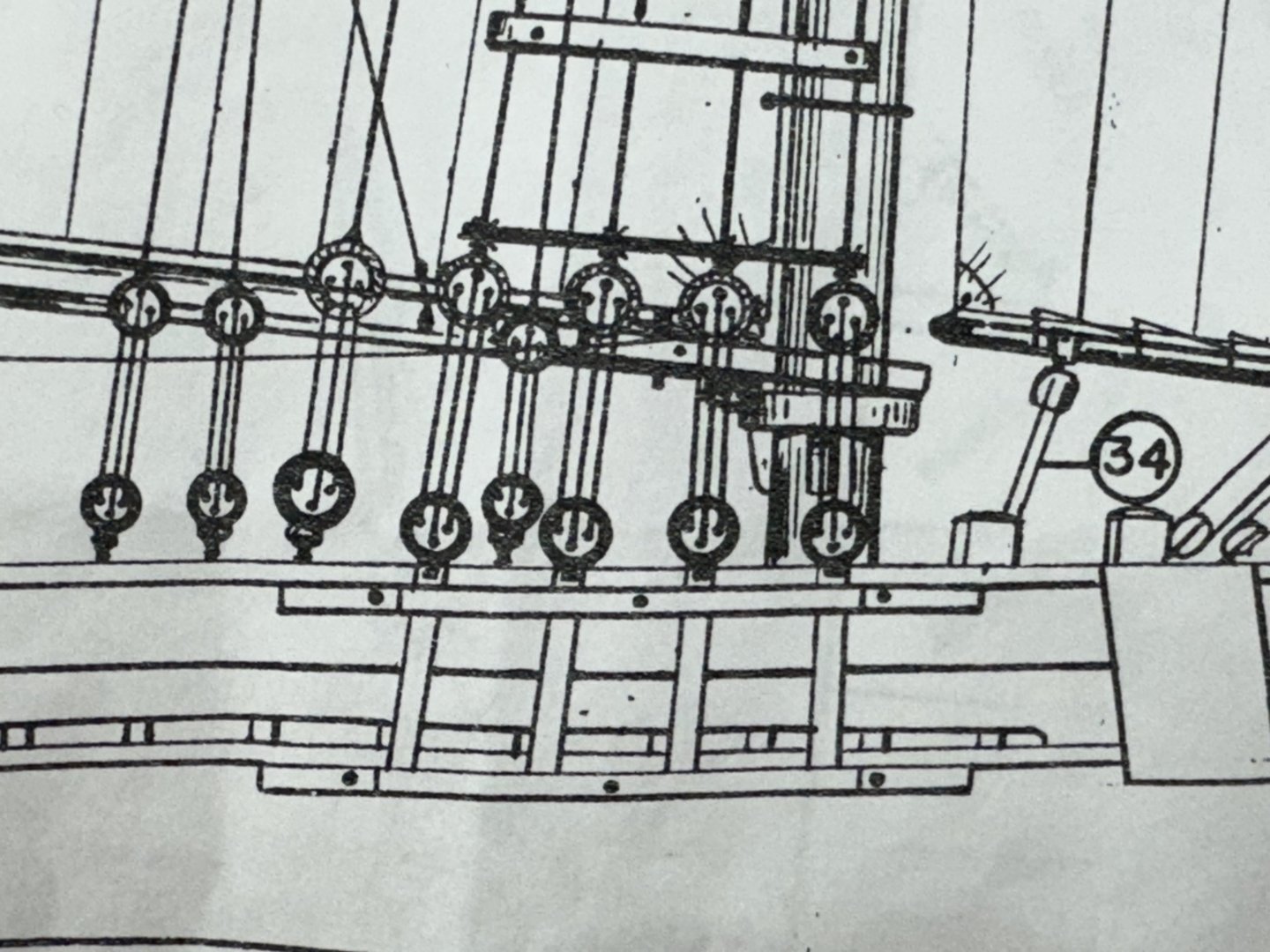-
Posts
1,896 -
Joined
-
Last visited
Content Type
Profiles
Forums
Gallery
Events
Everything posted by cdrusn89
-
After further consideration and a more careful viewing of the picture above I think the answer to how is the raffee furled is that is furled against the fore top mast on the forward side, not on the yard arm. Since I did not make the other topsails and do not have the time, materials or inclination to do so now I will dispense with the raffee and leave all the topsails off. I think it would look strange to have just the one upper sail in place. In fact I think that the raffee was probably only set when running more or less down wind while the other topsails would have been more useful at other points of sail. How someone gets up to near the top of the fore topmast to furl the raffee is a mystery to me - bosun's chair? So now to secure all the back stay and topmast shroud deadeyes and proceed with rigging the inter-mast stays.a
-
Everything I know about the Great Lakes schooners I learned at the Tall Ships Erie in 2019. Below is the Denis Sullivan which at the time was the "official tall ship of Milwaukee" (or maybe Wisconsin). She is now some sort of "school ship" in St. Croix according to the internet. Anyway the thing I found interesting was the single yard arm on the fore mast and that it was rotated out of the way when not in use, or presumably it might be tilted with the raffee sail (aka topsail) furled on the yard. The only rationale that comes to (my) mind for allowing the yard to rotate would be to allow the ship to moor to a pier where buildings (like warehouses) were very close to the pier for ease of loading/unloading. However, since two of five stay running forward from the fore mast pass through a cut-out in the sail the sail would have to be furled sort of "around" these stays. As you can see in the picture the yard is bare so no help here. And of the tall ships I have seen in the US no other one carries a rig like this so... I have the yard in place on the model and able to rotate. I originally furled to raffee sail on the yard but I have since unfurled it and am letting it dry now. Plan is to tie the sail on the yard - sail plan shows it tied on at lower corners and at the edges of the cut-out for the stays - attach the halyard and raise the sail - then spray a little water on the sail and see what can be done about furling it. I have an idea how the sail would be rigged on the real ship. If the yard was tilted to one side you could reach the sail attachment points on one side from the ratlines, then tilt the yard the other way and do the other side - then level the yard, attach the halyard and haul away. Probably not too difficult unless the weather is not cooperating which on the Great Lakes can be much of the time.
-
The mizzen mast turned out to be a bit more problematic than the main/fore. In addition to tightening one side and lossening the other back stay/topmast shrouds I had to rerigged the lower shroud deadeyes on the starboard side as they the lower shrouds had become noticeably loose after the back stays/upper shrouds were tightened. In any event i managed to get the mizzen mast straight. It was much easier to get the laser on the hull centerline at the stern as there are obvious reference points (rudder et al) By the seaman's eye all three masts appear to be in alignment. I am not sure how I will deal with the list of the model on the display stand. I can correct for the photos and then crop the base out of the photos) but when "on display" the list would detract from the overall appearance - maybe a discreet wedge or two under the baseboard would work - I am not sure redoing the screws in the solid hull can be done by me) is such a way as to guarantee the model is perpendicular to the base.
-
I got all the back stays and topmast shrouds installed and lanyards revered but not yet secured (good thing). I cleaned off the workbench (more or less) and took the model off the turntable which makes switching sides while rigging much easier. It does however present challenges to keeping everything clear of the "swing radius", especially of the bowsprit/jib boom. First order of business was to get the model level. As at least an approximation of this I used a thick plastic ruler across the cap rail amidships and stuck thin pieces of wood under the baseboard until I got an indication of level. For those interested the model was 2.5 degrees out of level. I turned out the workbench lights and set up the laser level to see if the masts are straight. I fiddled with the back stays and topmast shrouds on the fore mast until I got the laser light on the entire mast. Disregard that toothpick I got the fore mast straight without it. The bowsprit (jib boom actually) is just a bit over to port - you can just see the laser light on the down haul block just behind the first two stays. Need to tighten up the starboard side guys on the jib boom. Since the fore mast blocks most of the light from getting to the main mast I had to use the "seaman's eye" to adjust the main mast back stays/shrouds to get it in line. I could not get the light to hit the very top of the mainmast but it is "really close". So now I have to go secure the main and fore mast back stays and top mast shrouds in these positions before everything "springs back" out of shape. Once I have the main/fore "squared away" I will turn the model around and see how the mizzen masts looks. Hopefully the main mast will now be the "gold standard" and I can adjust the mizzen to line up with the main. Once all the stays/shrouds are secured I can get the yardarm/raffee in place. Given that three of the fore mast stays pass through the raffee I will have to unfurl at least part of the raffee to pass the stays through. Should be an interesting evolution.
-
Proceeding apace I decided to get the after end of the ship "finished", except for the final tensioning of the backstay/top mast shrouds and the inter-mast stays. I took the pictures in my make shift "photo studio" which I hope to use to take the pictures for the NRG model contest, assuming I get the Simpson finished by the end of the month. Pay no attention to the bottom surface. I have been promised a white sheet to cover up the wood working bench. So here is the mizzen mast with all the rigging that I intend to provide in place. The only new running rigging is the topsail halyard and down haul which you can see joined together aft of the throat/peak/topping lifts. I ran the down haul through the small block at the aft end of the gaff, along the boom and then down to the deck. I have a rope coil that will go on top of the cabin roof where the down haul line leads down from the boom. After i got the topmast shrouds/back stays connected and the deadeyes lashed up I added the railing along the stern rail. Next up was the boat and davits/tackle. Since there was no boat included with the kit I used a vanguard 1/64th, 3-D printed boat (18' cutter) which is probably too wide and too short to fit under the davits and not hit the stern. Given my unwillingness to pursue a different boat at this late date I decided to mount the boat on a skid on the cabin roof to starboard of the mizzen mast. I toyed with the notion of fabbing a cover from the left over sail material but gave up when I could not figure out the correct shape of the cover and not wanting to cover the work I had done on the boat interior. Here is an overall view of the stern from the quarter (the whole ship in this view is one of the required photos for the NRG contest). So with the boat on deck I turned to davits inboard and added a eyebolt and cleat to hold the boat tackle in place. It is hard to see but there are coils of the boat tackle on deck below the cleats. I used Bluejackets .005" white line for the boat tackle as it is the smallest line i have. Here is a shot of the "quarterdeck with the davits and tackle in place. Hard to get the camera to focus on the deck but you can see the white rope below the davit. And this is another required shot (directly astern). And yes I know the ship is listing slightly to starboard. That happened the last time I had to fiddle with the mounting screws. I am waiting until everything is DONE before I try and tackle that issue. But at least the masts seem to line up correctly and I had to drill the mast holes.
-
I know it has been like three weeks since I last posted but I have not been idle. I have all the lower shrouds and ratlines in place. I used the ratline spacing template I had from Sphinx which are 6mm apart. Since Simpson is the same scale I decided 6mm was "good enough". I used .030" Syren line for the shrouds. The plans said .027" but I decided to go a size larger (Syren comes in .025 and .030) and to use .005" black line for the ratlines (from Bluejackets). I have previously used Syren .008" line for the ratlines at this scale but like the .005 since I believe it is 100% cotton and ties better (and obviously) smaller knots (and is considerably cheaper). The instructions suggest gluing the ratlines on rather than tying them but the Bluejackets line comes on a regular thread spool and has a good bit of twist in it that does not fall out even after 4 days hanging with a weight on the end. I built a test jig to see if gluing was an option (for me). I coating the thread with dilute white glue and hung it up to dry. I had to have the jig on its side (and turn off the ceiling fan) to get the thread to "stick" and would only be able to do one ratline on each mast as touching anything before the glue dried caused movement of the ratline just placed. Soooo I decided to tie the standard clover leaf knots as I have done before. The mizzen ratlines are the easiest since there are only three shrouds and only every fifth ratline covers all three shrouds. Don't ask me how I know but it takes a mind shift when switching sides on the mizzen as the shrouds with ratlines every 6mm are on the left now, not the right. I added boom rests for all three booms since I needed something to "pull against" when tensioning the topping lifts and peak halyards. I find it hard to believe that the real ship did not have removable boom rests - probably not where I put them but there somewhere. I also rigged the boom sheets and added rope coils on deck after belaying the sheet lines as shown on the plans. I I added the side lights but used platforms and bulbs from Billings Boats. They are a bit larger than the Britannia metal parts that come with the kit but I think they look better. A sailor climbing the forward ratlines would have to step over either set. I finally got around to adding the capstan bars and stowage location. I populated all the pin rails except the three at the extreme bow including rope coils. I decided that the only running rigging on the Main and Mizzen top masts would be the top sail halyards and since these start at the becket of the block at the top of the mast I added them to the pin rail and coiled up a sufficient quantity of line so I will rig this "in reverse". I followed the same tactic with the five halyards at the fore mast. The lines are coiled up on plastic tubes and labeled with the sail (although the lines are pretty much all the same length). Here are two shots of the ship from the quarters.
-
All three lower masts are now on the hull. The Fore and Main peak and throat halyards and the topping lifts are in place and secured, at least by clamps after passing through the the respective pin board hole. When I got to the mizzen I realized that the pin rails there (and I think at the bow) are going to be a problem. The instructions call for 3/32" X 5/32" material for the pin rails. Those work out fine at the Fore and Main masts but because the bulwarks are shorter on the quarterdeck (13mm vs 5mm below the cap rail) the 3/32" thickness ( 2.5mm) leaves a pretty narrow opening below the bottom of the pin rail. There are similar measurements at the pin rails on the forecastle but there is no deckhouse getting in the way up there. I am in the process of fabbing new pin rails from 1/16" X 3/16 stock. Hopefully I can get these installed without messing up the deckhouse or the bulwark. I am not sure the additional 1/32" is going to "solve" the problem but it is a step in the right direction. It is not clear to me how anyone could use the pin rails as provided - even sticking the line in the pin rail hole and jamming a belaying pin to secure it would be problematic. And yes I recognize that the Fore mast is racked back too much. I hope to correct this to some extent when all the forward leading stays are in place and tightened.
-
Welcome aboard Mark. This is kind of a unique build log as to the best of my knowledge this is the only build log of a AJ Fisher kit although they have been in business a very long time (100 years). And as I have stated a few times this kit is not for a novice - there is not a single laser cut piece in the entire kit save the decking material. Everything is built the "old fashioned way" aka out of strips of basswood. I have the lower Fore Mast, boom and gaff in the hull and the halyards and topping lifts/lazy jacks in place. I decided I would mount all the lower masts before starting the shrouds and other standing rigging for the lower masts. I am not sure this is the "optimum" sequencing but if it isn't I will surely let you know. So I placed the lower Main Mast in the hole I drilled in the hull and - either the main mast hole is too far aft, the mizzen mast hole (or maybe the whole deckhouse) is too far forward or the boom is too long by about 9mm. Or at least that is how much I cut off. The main boom will just not have as long or tapered ending as the fore and mizzen. So i have shortened the boom (see cut mark above) and am working on getting a new band built and eyebolts installed as this is where the topping lifts terminate.
-
Mizzen mast is almost done. I have not rigged the lazy jacks yet and think I will wait until the mizzen mast is on the hull to do that. I "think" I have the boom at the correct height above the deck (top of deckhouse actually) on the mast stand but want to be sure it is in the correct place. I may have to rerig the fore mast as I originally rigged it with the boom a couple of inched too high. When I lowered it I think some of the lazy jacks may now be too short. Not really a big deal just disappointing that I was not smart enough to figure that out in the first place.
-
After several starts and restarts I finally got the raffee furled on the yard arm. not the neatest job but serviceable, at least for now. The potential fly in the ointment is that the fore stay has to pass through the raffee to connect to the fore top mast. I built a jig with a mast, yard arm and fore stay to try and furl the raffee on that but it proved unworkable, at least for me. I wonder just how the crew managed to furl the raffee since there are no foot ropes shown on the yard arm and there are no ratlines on the top mast stays/back stays. The only thing I can figure out is they used the yard lifts to tilt the yard so they could reach it, one side at a time, from the lower mast ratlines and trestle top. Must have been interesting in rough weather. Hopefully the skipper only used it in good weather and furled it well before rough weather. The jig I used is shown below, the vertical dowels acted like lazy jacks to keep the sail contained more or less over the yard arm. Now to the mizzen sail and once that is done it will be time to install the masts on the hull.
-
So here is the raffee sail (suitably shortened) and yard arm ready for punching the holes. I use a .5mm hole punch (made for putting holes in leather) to reduce the amount of "flashing" around the hole). And then mounting and, hopefully furling. For the mizzen sail I started with the template I made of the main and used the mizzen boom and gaff to figure out where it needed to be reduced to fit the mizzen spars. Cut the template as marked and here is the template for the mizzen sail.
-
While working on the Raffees sail (aka top sail) I noticed a discrepancy between the top sail yard dimensions between what is shown on the sail plan and what it shown on the layout drawing. The sail plan shows a yard that is 4 7/8" from the mast centerline to the end of the yard. The arrangement drawing says that dimension is 4.5". Here is the template I made for the sail based on the sail plan (which only shows half of the sail). So i have to trim about .5" off the bottom of the sail to keep the ends inboard of the end of the yard arm. While the raffee sail was drying after cutting it out and applying the reinforcing parts I looked at the mizzen sail. The discrepancy was even more extreme for the mizzen sail. The mizzen boom, per the arrangement drawing is 7.5" from the mast center to the end. Measured on the sail plan the boom is only 6 1/8" long. I checked the mizzen boom on the hull and the sheet blocks match up so that is not going to a problem but the mizzen sail is going to have to be considerably longer at the foot than is shown on the plan to have the mizzen sail come close to utilizing the more or less entire boom as is do on the fore and main.
-
Main sail and mast completed to the same "degree" as the Fore. You can see my "mast support 2.0" here (the 1.0 version is in the background). I have learned that a 2X4 is not all that stable, especially when the sides are not sharp (as they generally aren't as purchased from Home Depot, etc.). Here is better shot of the main alone. I am going to work on the Top Sail (called Raffees on the sail plan) next as I anticipate the Mizzen sail to be a rinse and repeat of the Main/Fore.
-
Main sail is completed , attached to the spars and mounted on the "Furling jig". The sharp eyed will notice that one of the mast hoops has become detached from the sail. Not that hard to do (IMHO) but given it will be in the "middle of the pile" of mast hoops it is probably no big deal. I will have to use a smaller dowel for the Mizzen as that mast is 5/16" instead of 3/8" like the main and fore. Now to the "fun" getting the sail furled without doing further damage. After it is furled I will remove it (carefully), use some rubber bands to keep it "together" and transfer it to the real main mast, add the boom rest and mast coat and then start the throat and peak halyards and topping lifts just like on the fore mast.
-
I believe I have the lower Fore Mast about as complete as I can get it at this stage. The throat and peak halyards are rove and the block and becket/line are in place for the hauling end of each. The topping lists (there are two, one on each side) and lazy jacks are in place as well. All of the lines are still adjustable as the boom is not on the boom rest so all the lines have plenty of slack as they will all need to be elongated when the mast goes onto the hull. I have not yet connected the yard sling chain as I may need to remove the yard to add the furled sail. I had to fabricate a "yard truss" to hold the fore topsail yard (the only yardarm on the vessel) as the Britannia item was too flimsy (IMHO) and I wanted the ability to swivel the yard "out of the way" as was done when these vessels needed the extra clearance next to the pier. I am also considering putting the furled fore topsail on the yard but need to make a "test jig" as the sail has a "notch" in the center to clear the fore stay. I am not sure how all this is going to work out so I need a way to rig the sail, furl it then rotate the yard. I will do it "off ship" first then maybe transfer the furled sail to the real yardarm. The sail is only held at the head and at each end - no complicated lashings so this might actually work But first I need to get the other two masts completed to the same level as the Fore. Do not ask me how I know but drilling out the deck hole for the fore mast to the 1 3/4" depth shown on the plans will come perilously close to going out the bottom of the hull.
-
Following Tom Luria's methodology (seen on YouTube) I fabricated the Fore Sail for the Simpson, lashed it to the boom and gaff and added the mast hoops. Then I made a little stand with a spare piece of 3/8"dowel to simulate the mast and "hung it up". I did not add the reefing bands/ties or the panel lines since the sail will be furled and much of this detail would be lost. I also made the sail only about three quarters as tall as shown in the sail plan. Previous experience has shown (me) that the larger the sail the more difficult it is to get it furled "properly". Not to say that mine are properly furled, just enough to look more or less "presentable" IMHO. Continuing on with the fore mast I added the rest of the detail using laser board for the bands around the square section and the required blocks. I glued on the trestle trees, added the mast cap and rigged the spreader lifts (using turnbuckles instead of deadeyes - I just could not manage to get the 3mm deadeyes to "work" - too small for my old eyes and hands). I fabricated the "stay irons" from brass flat stock and brass eyebolts soldered into the brass stock. At least I remembered how to do that as it has been many years and models since I had to solder brass fitting together. With the fore mast more or less completed (I am sure I forgot something) I furled the sail and added it to the mast along with the mast cap and the boom rest. Then I rigged the throat and peak halyards - took a bunch of line with the gaff down on top of the boom. Next up are the topping lifts and lazy jacks - then on to the Main sail.
-
I think I have the hull completed as far as I can before turning my attention to the spars and rigging. I added the bowsprit shrouds (chain) and the martingales (also chain) but have not completely tightened the lashings (hence the sag). I do not want to tension anything untill all the standing rigging is more or less in place. At this point it is hard to tell what might influence what. I added the six head sail sheet blocks (three on each side). They form part of the hauling tackle for each jib (jib topsail, standing jib and flying jib). They are on pendants to make it easier to rig them. Not sure if I could really get at them if they were on the deck. Likewise I added the bottom blocks (doubles) on deck for the throat and peak halyards for the gaffs. I put the mizzen blocks on pendants as well since there isn't much room between the bulwark and deckhouse and the pin rail is also in the way. Channels and chainplates are in place on both sides along with the cap rail mounted deadeyes. This is the starboard side. Initially i was going to use the kit supplied lower links (although there were not enough and they looked to be too long but...) but they proved to be (for me) too difficult to remake and I chose to shift to 3/32" X 1/64" Britannia metal strips. If I had it to over again I would probably use those strips (or 1/16" X 1/64" ones) for the lower links instead of the 24 ga wire. Still some touch up to do and one bolt head appears to have carried away. One note on the cap rail mounted deadeyes, the fore mast arrangement is shown on the sail plan rather than with the rest on the arrangement drawing, but there is a "extra" deadeye which is not labeled, listed on the rigging table nor can I figure out where it might terminate. I have left it off. It is the sixth one (from the bow) in the drawing below. Now on to the spars and sails.
About us
Modelshipworld - Advancing Ship Modeling through Research
SSL Secured
Your security is important for us so this Website is SSL-Secured
NRG Mailing Address
Nautical Research Guild
237 South Lincoln Street
Westmont IL, 60559-1917
Model Ship World ® and the MSW logo are Registered Trademarks, and belong to the Nautical Research Guild (United States Patent and Trademark Office: No. 6,929,264 & No. 6,929,274, registered Dec. 20, 2022)
Helpful Links
About the NRG
If you enjoy building ship models that are historically accurate as well as beautiful, then The Nautical Research Guild (NRG) is just right for you.
The Guild is a non-profit educational organization whose mission is to “Advance Ship Modeling Through Research”. We provide support to our members in their efforts to raise the quality of their model ships.
The Nautical Research Guild has published our world-renowned quarterly magazine, The Nautical Research Journal, since 1955. The pages of the Journal are full of articles by accomplished ship modelers who show you how they create those exquisite details on their models, and by maritime historians who show you the correct details to build. The Journal is available in both print and digital editions. Go to the NRG web site (www.thenrg.org) to download a complimentary digital copy of the Journal. The NRG also publishes plan sets, books and compilations of back issues of the Journal and the former Ships in Scale and Model Ship Builder magazines.



